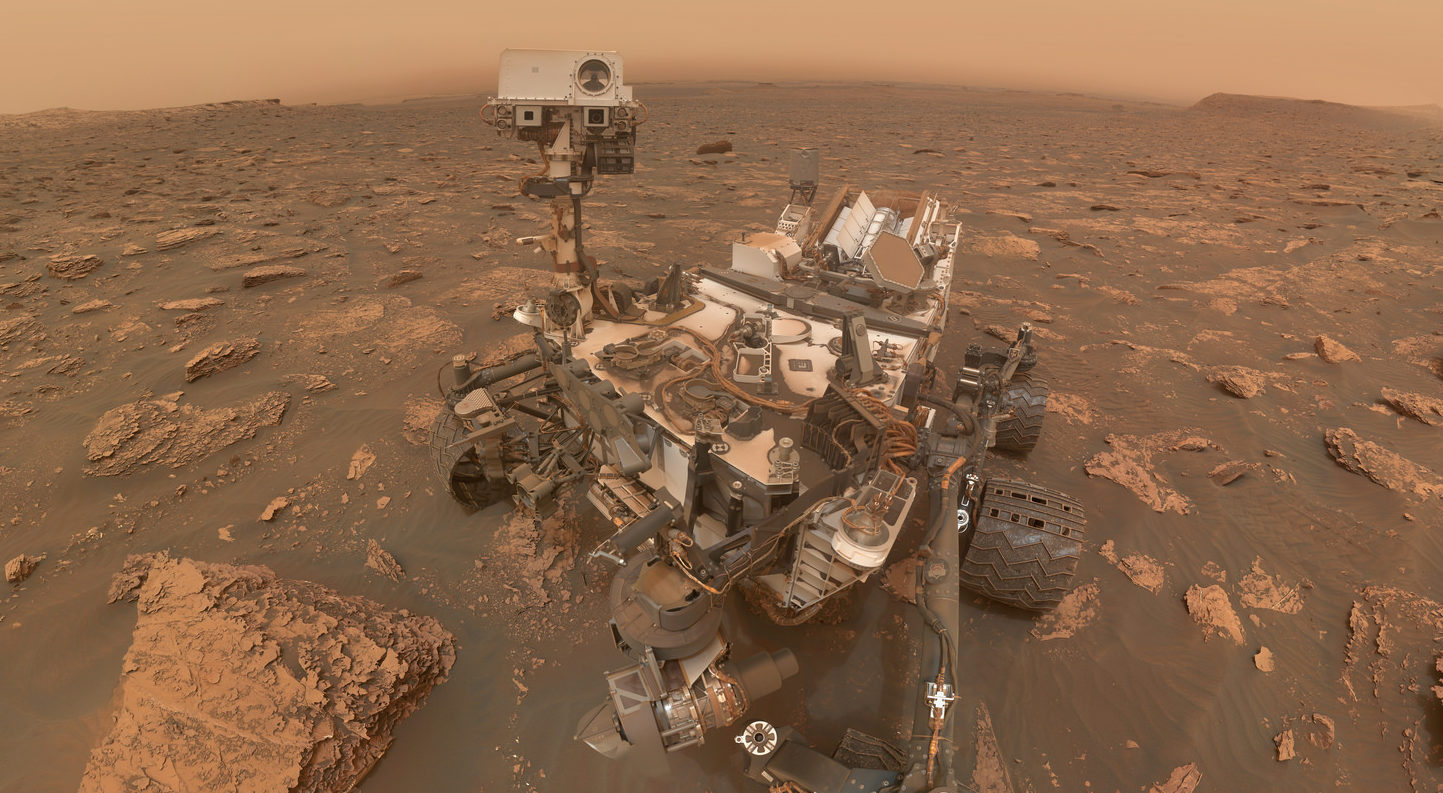
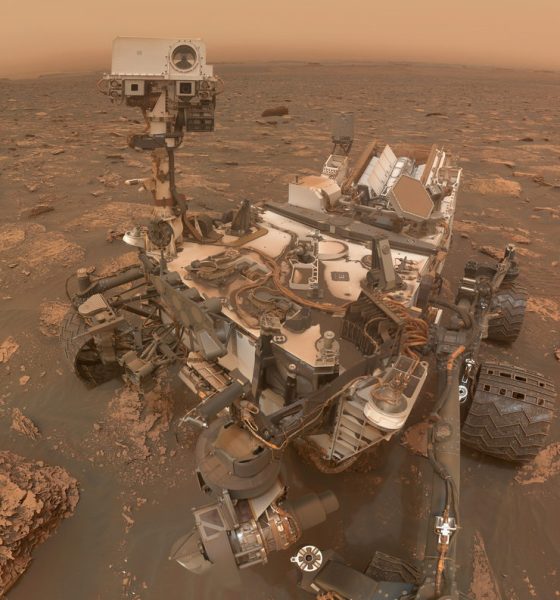
News
Mars rover to Earth, this red planet has a methane problem
NASA’s Curiosity rover has been exploring an area of Mars called Gale Crater, since landing on the red planet in 2012. It was tasked with assessing the habitability of Mars. What was Mars like in the past? Were the conditions right for life?
Let’s be clear, Curiosity was not equipped with the instruments needed to identify life forms, but it can tell us if conditions were right for life to have survived.
Throughout its time on the red planet, Curiosity has discovered a bit of an enigma: Mars has methane and the abundance changes with the seasons. Big surges of methane can indicate that some sort of biological process is taking place, but that’s not always the case. And it’s not a definitive sign of life.
Methane is a gas produced by one of two methods on Earth: biological and geological. That means that some sort of life form could be producing or perhaps there’s some sort of geological explanation.
This is puzzling to scientists back on Earth because the Martian methane has been detected by ground-based telescopes. But recent orbital data from Mars shows the minuscule amounts of methane are gone.
In fact, the Trace Gas Orbiter (TGO)—a joint European and Russian mission—which launched in 2016 and was designed to sniff-out trace gases, such as methane, says the Martian air is basically methane-free.
But, NASA’s Curiosity rover may have just taken a big step forward in understanding this conundrum.
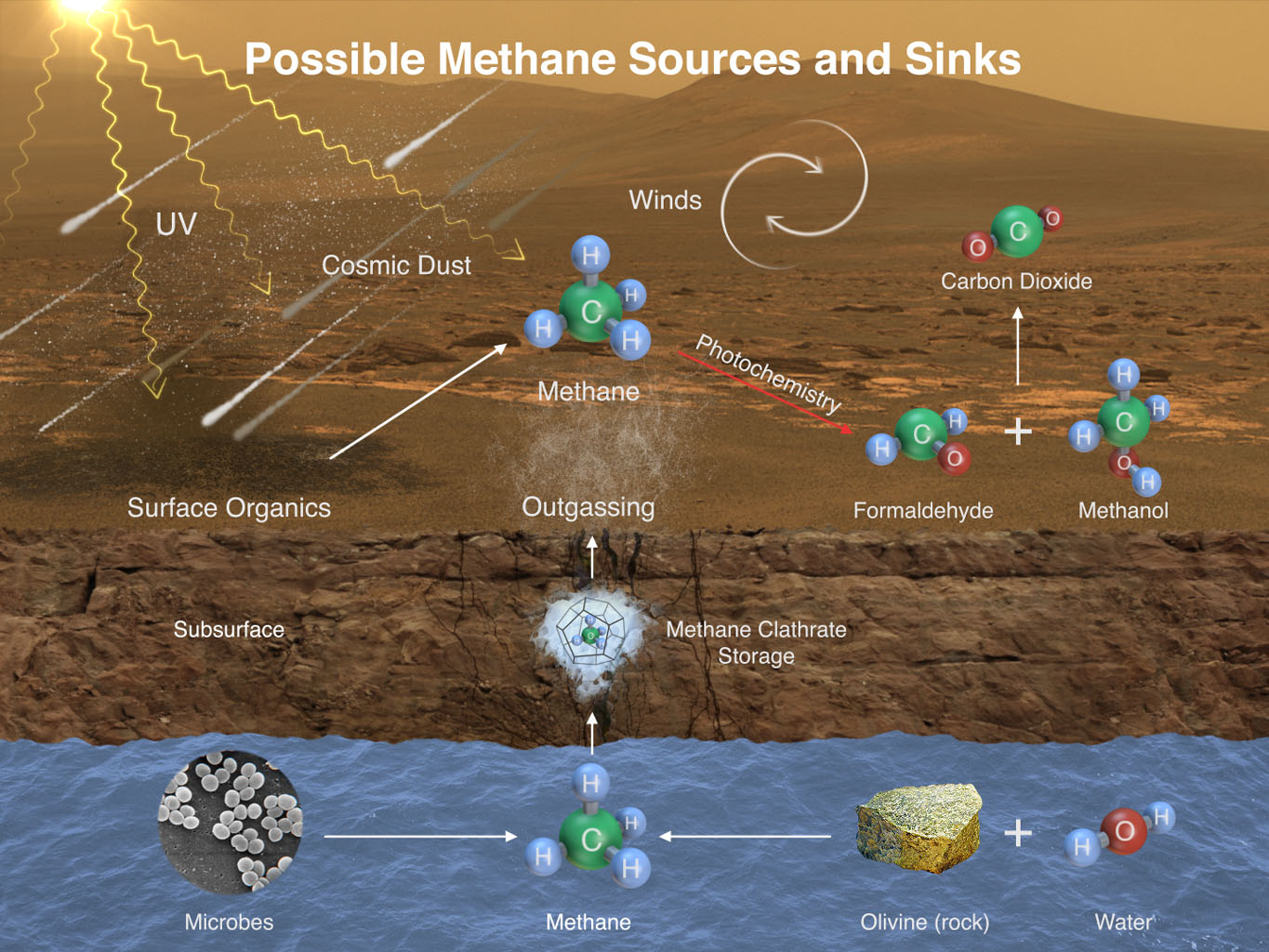
Curiosity’s detection of methane is nothing new. The six-wheeled rover has detected surges in methane throughout its mission. The most recent occurrence, recorded in June 2019, showed staggeringly high levels of methane—21 ppb (parts per billion). That’s the highest the rover has recorded to date.
Neither TGO nor its counterpart, the Mars Express orbiter, detected any methane at all in June.
TGO has detected minute amounts of methane—around 0.012 ppb—during its first few months of science operations. That’s equivalent to roughly 30 times less than what Curiosity sees. (Mars Express did detect the first methane surge that Curiosity spotted in June 2013.)
Why is there such a discrepancy between ground measurements and orbital data? The Curiosity science team has a few ideas.
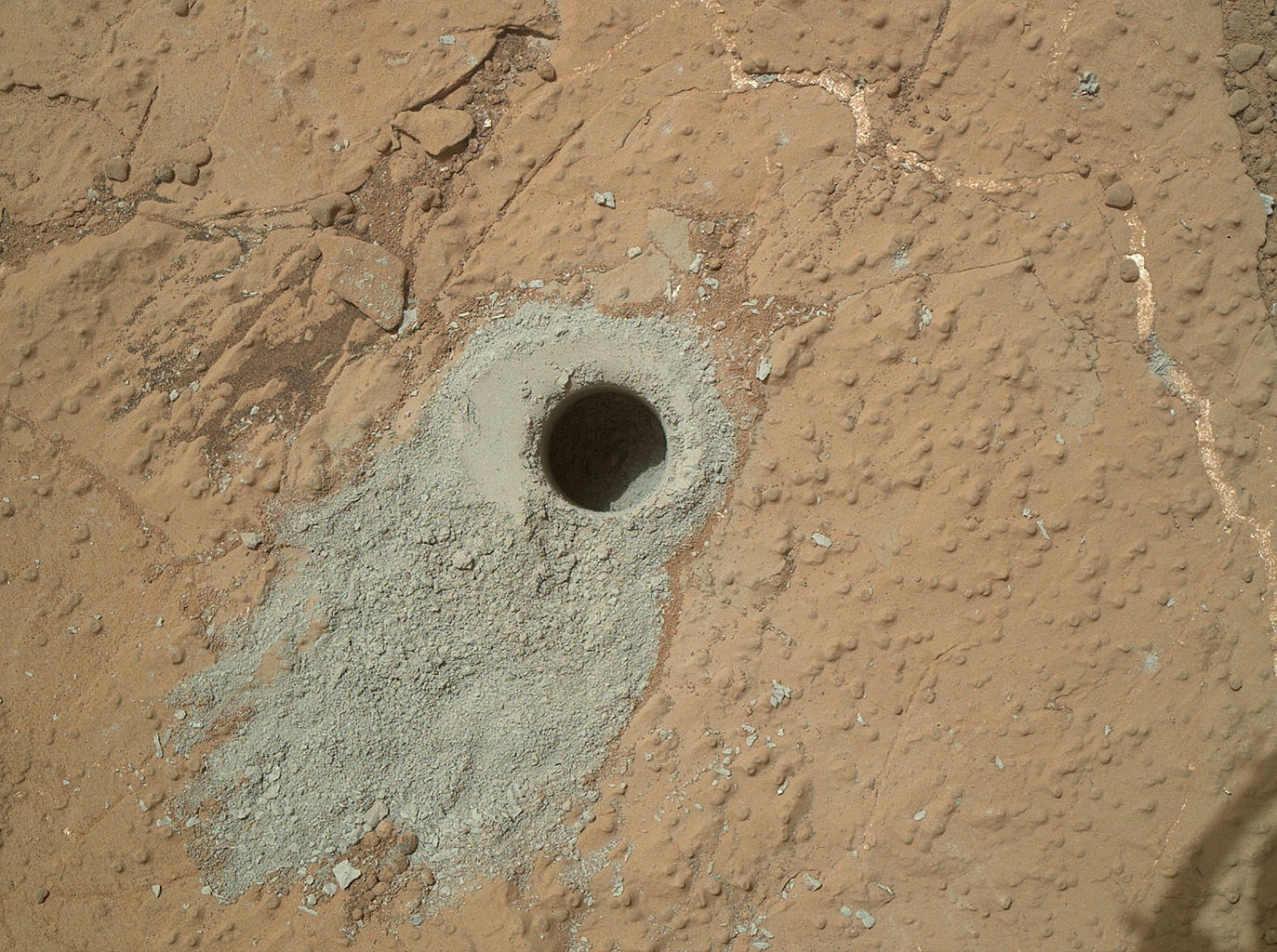
First off, there could be some sort of atmospheric process taking place that is scrubbing it out of the atmosphere. Curiosity takes measurements on the ground and detects the methane, while TGO orbits the planet and does not. This means that something happens to it as it travels upwards through the atmosphere.
Another explanation could be atmospheric expansion and contraction. Mars has an atmosphere, albeit an incredibly thin one compared to Earth’s. Every day the heat from the sun causes the atmosphere to expand and contract.
As the atmosphere expands during the day, the methane could become more diffuse. Since Curiosity measure methane at night, when the rover is less busy, it could explain why the methane appears more abundant. That means that the rover is sniffing the atmosphere when its more dense, which means the methane concentration would be greater.
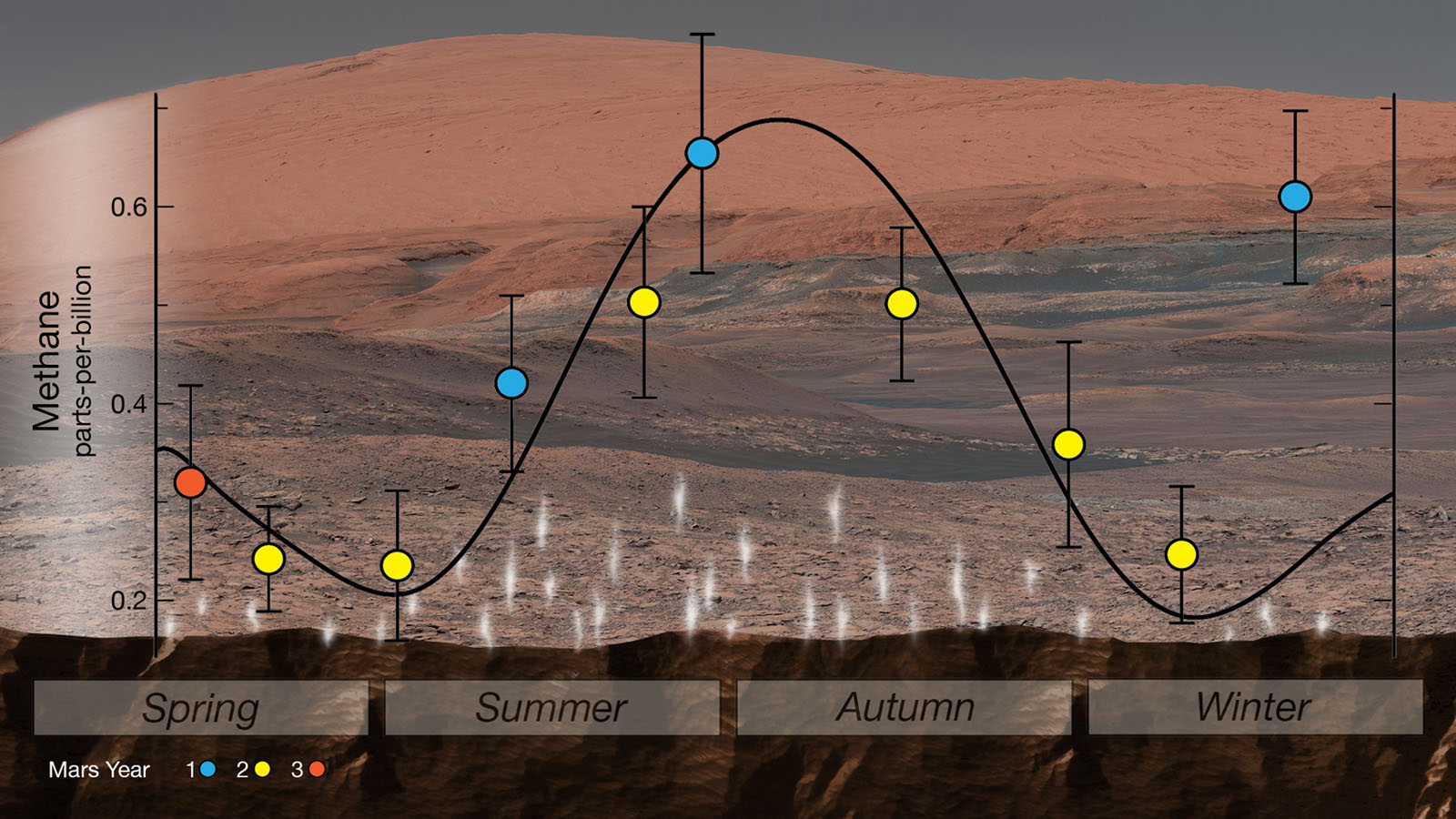
The team plans to take some daytime methane measurements and compare those with orbital data. This will give the team some insights into why the data is so different. Once they have that puzzle solved, they can move onto larger questions, like what generates the methane?
It’s also entirely possible that the gas may have been generated billions of years ago in deep, underground pockets, and it’s just now seeping up through the bedrock. Only time and more measurements can tell.
NASA is sending its next-generation Mars rover to the red planet this July. Dubbed the Mars 2020 rover, the vehicle is a souped-up version of Curiosity. This rover will not only be able to look for biosignatures (or signs of life), it will also bag up samples for a future return to Earth.

News
Tesla (TSLA) receives “Buy” rating and $551 PT from Canaccord Genuity
He also maintained a “Buy” rating for TSLA stock over the company’s improving long-term outlook, which is driven by autonomy and robotics.

Canaccord Genuity analyst George Gianarikas raised his Tesla (NASDAQ:TSLA) price target from $482 to $551. He also maintained a “Buy” rating for TSLA stock over the company’s improving long-term outlook, which is driven by autonomy and robotics.
The analyst’s updated note
Gianarikas lowered his 4Q25 delivery estimates but pointed to several positive factors in the Tesla story. He noted that EV adoption in emerging markets is gaining pace, and progress in FSD and the Robotaxi rollout in 2026 represent major upside drivers. Further progress in the Optimus program next year could also add more momentum for the electric vehicle maker.
“Overall, yes, 4Q25 delivery expectations are being revised lower. However, the reset in the US EV market is laying the groundwork for a more durable and attractive long-term demand environment.
“At the same time, EV penetration in emerging markets is accelerating, reinforcing Tesla’s potential multi‑year growth runway beyond the US. Global progress in FSD and the anticipated rollout of a larger robotaxi fleet in 2026 are increasingly important components of the Tesla equity story and could provide sentiment tailwinds,” the analyst wrote.
Tesla’s busy 2026
The upcoming year would be a busy one for Tesla, considering the company’s plans and targets. The autonomous two-seat Cybercab has been confirmed to start production sometime in Q2 2026, as per Elon Musk during the 2025 Annual Shareholder Meeting.
Apart from this, Tesla is also expected to unveil the next-generation Roadster on April 1, 2026. Tesla is also expected to start high-volume production of the Tesla Semi in Nevada next year.
Apart from vehicle launches, Tesla has expressed its intentions to significantly ramp the rollout of FSD to several regions worldwide, such as Europe. Plans are also underway to launch more Robotaxi networks in several more key areas across the United States.
News
Waymo sues Santa Monica over order to halt overnight charging sessions
In its complaint, Waymo argued that its self-driving cars’ operations do not constitute a public nuisance, and compliance with the city’s order would cause the company irreparable harm.

Waymo has filed a lawsuit against the City of Santa Monica in Los Angeles County Superior Court, seeking to block an order that requires the company to cease overnight charging at two facilities.
In its complaint, Waymo argued that its self-driving cars’ operations do not constitute a public nuisance, and compliance with the city’s order would cause the company irreparable harm.
Nuisance claims
As noted in a report from the Los Angeles Times, Waymo’s two charging sites at Euclid Street and Broadway have operated for about a year, supporting the company’s growing fleet with round-the-clock activity. Unfortunately, this has also resulted in residents in the area reportedly being unable to sleep due to incessant beeping from self-driving taxis that are moving in and out of the charging stations around the clock.
Frustrated residents have protested against the Waymos by blocking the vehicles’ paths, placing cones, and “stacking” cars to create backups. This has also resulted in multiple calls to the police.
Last month, the city issued an order to Waymo and its charging partner, Voltera, to cease overnight operations at the charging locations, stating that the self-driving vehicles’ activities at night were a public nuisance. A December 15 meeting yielded no agreement on mitigations like software rerouting. Waymo proposed changes, but the city reportedly insisted that nothing would satisfy the irate residents.
“We are disappointed that the City has chosen an adversarial path over a collaborative one. The City’s position has been to insist that no actions taken or proposed by Waymo would satisfy the complaining neighbors and therefore must be deemed insufficient,” a Waymo spokesperson stated.
Waymo pushes back
In its legal complaint, Waymo stated that its “activities at the Broadway Facilities do not constitute a public nuisance.” The company also noted that it “faces imminent and irreparable harm to its operations, employees, and customers” from the city’s order. The suit also stated that the city was fully aware that the Voltera charging sites would be operating around the clock to support Waymo’s self-driving taxis.
The company highlighted over one million trips in Santa Monica since launch, with more than 50,000 rides starting or ending there in November alone. Waymo also criticized the city for adopting a contentious strategy against businesses.
“The City of Santa Monica’s recent actions are inconsistent with its stated goal of attracting investment. At a time when the City faces a serious fiscal crisis, officials are choosing to obstruct properly permitted investment rather than fostering a ‘ready for business’ environment,” Waymo stated.
News
Tesla FSD v14.2.2 is getting rave reviews from drivers
So far, early testers have reported buttery-smooth drives with confident performance, even at night or on twisty roads.

Tesla Full Self-Driving (Supervised) v14.2.2 is receiving positive reviews from owners, with several drivers praising the build’s lack of hesitation during lane changes and its smoother decision-making, among others.
The update, which started rolling out on Monday, also adds features like dynamic arrival pin adjustment. So far, early testers have reported buttery-smooth drives with confident performance, even at night or on twisty roads.
Owners highlight major improvements
Longtime Tesla owner and FSD user @BLKMDL3 shared a detailed 10-hour impression of FSD v14.2.2, noting that the system exhibited “zero lane change hesitation” and “extremely refined” lane choices. He praised Mad Max mode’s performance, stellar parking in locations including ticket dispensers, and impressive canyon runs even in dark conditions.
Fellow FSD user Dan Burkland reported an hour of FSD v14.2.2’s nighttime driving with “zero hesitations” and “buttery smooth” confidence reminiscent of Robotaxi rides in areas such as Austin, Texas. Veteran FSD user Whole Mars Catalog also demonstrated voice navigation via Grok, while Tesla owner Devin Olsen completed a nearly two-hour drive with FSD v14.2.2 in heavy traffic and rain with strong performance.
Closer to unsupervised
FSD has been receiving rave reviews, even from Tesla’s competitors. Xpeng CEO He Xiaopeng, for one, offered fresh praise for FSD v14.2 after visiting Silicon Valley. Following extended test drives of Tesla vehicles running the latest FSD software, He stated that the system has made major strides, reinforcing his view that Tesla’s approach to autonomy is indeed the proper path towards autonomy.
According to He, Tesla’s FSD has evolved from a smooth Level 2 advanced driver assistance system into what he described as a “near-Level 4” experience in terms of capabilities. While acknowledging that areas of improvement are still present, the Xpeng CEO stated that FSD’s current iteration significantly surpasses last year’s capabilities. He also reiterated his belief that Tesla’s strategy of using the same autonomous software and hardware architecture across private vehicles and robotaxis is the right long-term approach, as it would allow users to bypass intermediate autonomy stages and move closer to Level 4 functionality.








